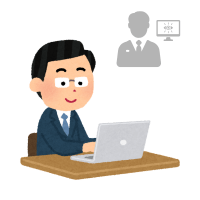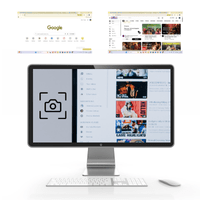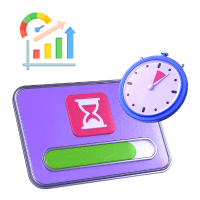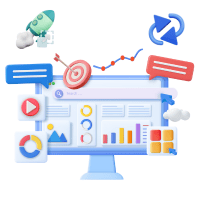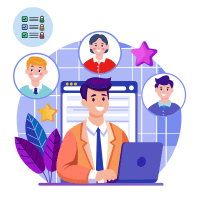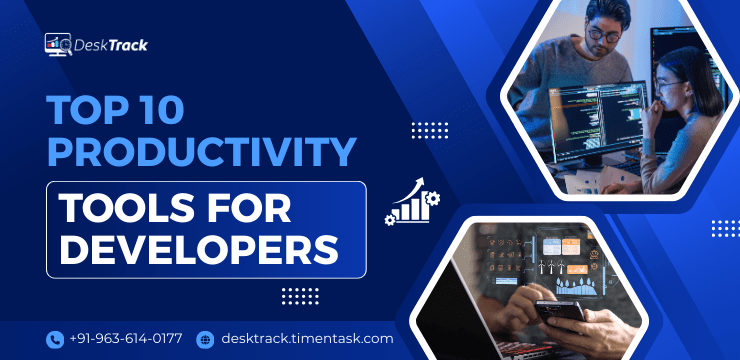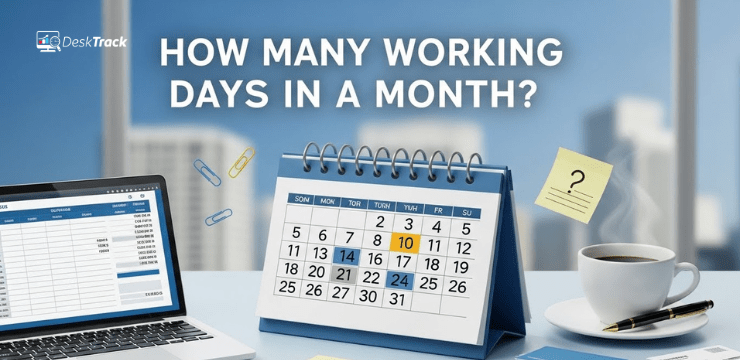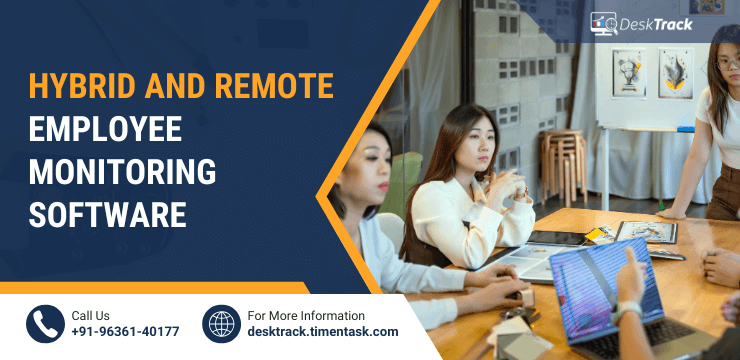
The world of work has dramatically transformed in recent years. Remote and hybrid work models have become increasingly popular, offering flexibility for employees and significant cost savings for businesses. However, this shift also brings challenges, particularly when it comes to maintaining productivity, tracking employee engagement, and ensuring data security.
Enter hybrid and remote employee monitoring software – a powerful solution designed to help businesses navigate these new working landscapes. These tools allow companies to monitor employee performance, productivity, and well-being without invading their privacy. They also provide crucial insights into workflow optimization and help foster a transparent, accountable work culture.
In this blog, we will explore the top 10 benefits of using hybrid and remote employee monitoring software in 2025. As the workplace continues to evolve, understanding these advantages will help organizations make informed decisions on how to enhance their hybrid and remote teams’ effectiveness. By the end, you’ll understand why DeskTrack is the ultimate employee monitoring tool for your business.
What is Hybrid and Remote Employee Monitoring Software?

Hybrid and remote employee monitoring software refers to digital tools designed to track, measure, and manage the productivity and performance of employees working remotely or in hybrid work environments (a combination of remote and in-office work). These software solutions help businesses oversee their distributed teams without the need for constant physical supervision.
As the nature of work continues to evolve, especially with the rise of flexible work arrangements, these tools are becoming increasingly essential for organizations to ensure that employees are staying on task, meeting deadlines, and performing to the best of their abilities.
These tools use advanced technology to track various aspects of employee behavior, work habits, and performance. The data collected is then analyzed to provide actionable insights that help businesses optimize workflows, increase productivity, and improve overall team collaboration, all while fostering a positive work culture.
Read Also: Top 10 Project Management Software for Salesforce: Features & Benefits
Key Features of Hybrid and Remote Employee Monitoring Software

- Time Tracking: Records the amount of time employees spend working, either by monitoring activity levels, keystrokes, or specific applications they use.
- Activity Monitoring: Tracks how employees spend their time during work hours, including which apps, websites, and documents they interact with. This can help identify time spent on work-related tasks versus distractions.
- Performance Reporting: Generates detailed reports and dashboards to evaluate the productivity levels of individual employees or teams, making it easier to identify areas for improvement.
- Screen Monitoring and Screenshots: Allows employers to take screenshots or record screen activity periodically, ensuring that employees remain focused on work-related tasks.
- Project and Task Management: Helps assign, track, and prioritize tasks for employees, ensuring that projects are completed on time.
- Employee Well-being Tools: Some software comes with features like mood tracking or feedback mechanisms to ensure employees maintain a healthy work-life balance, a crucial aspect of remote work environments.
Why Use Hybrid and Remote Employee Monitoring Software?
Make your workday more productive
Time tracking and work management can help you reach your goals
faster.
- Enhance Productivity: Managers can identify bottlenecks and optimize workflows by tracking employee activity and task completion rates.
- Ensure Accountability: By providing transparency and clear performance metrics, these tools ensure that employees remain responsible for their work, even when working remotely.
- Boost Employee Engagement: Monitoring tools can provide valuable feedback to employees, helping them improve their performance and feel more connected to their work.
- Ensure Compliance and Security: These tools help businesses monitor adherence to company policies and protect sensitive data, which is especially critical for remote teams working outside of a centralized office network.
When implemented with respect for privacy and open communication, hybrid and remote employee monitoring software helps organizations create an environment of trust and productivity while maintaining flexibility for employees.
Benefits of Using Hybrid & Remote Employee Monitoring Software in 2025
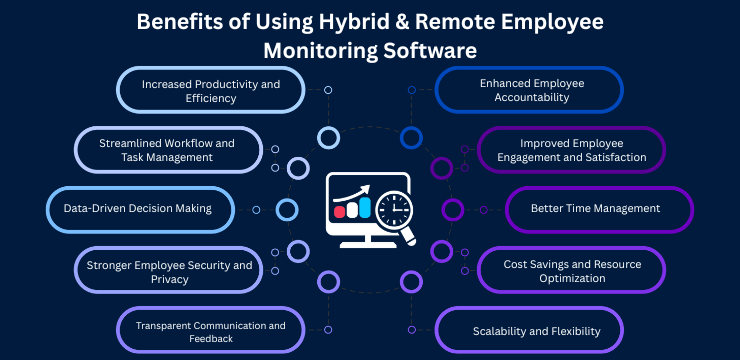
As businesses continue to adapt to hybrid and remote work models, the need for effective management tools becomes increasingly vital. Hybrid and remote employee monitoring software not only ensures that teams remain productive and accountable but also offers valuable insights into workflow optimization and employee engagement.
In this section, we’ll explore how these software solutions provide concrete benefits, from improving productivity to enhancing communication, security, and employee well-being. Understanding these advantages will help you see why investing in such tools is crucial for staying competitive in the evolving landscape of work. Let’s dive into the top benefits of using employee monitoring software in 2025.
1. Increased Productivity and Efficiency
One of the primary reasons businesses invest in hybrid and remote employee monitoring software is to boost productivity. With remote employees spread out across various locations, it can be difficult to gauge how effectively they’re working. Monitoring software provides valuable insights into how employees are spending their time.
Key Productivity Insights:
- Time Tracking: Monitor how much time is spent on different tasks, projects, or applications.
- Distraction Detection: Identify and minimize distractions by tracking non-work-related activities.
- Real-time Analytics: Get real-time reports on employee activity, making it easier to address potential issues before they escalate.
By analyzing these insights, managers can identify bottlenecks, allocate resources more effectively, and encourage employees to stay focused on tasks that directly contribute to their roles.
2. Enhanced Employee Accountability
Hybrid and remote employee monitoring software provides a transparent framework for accountability. When employees know their actions are being tracked, they tend to stay more focused on their work.
Key Accountability Benefits:
- Clear Expectations: Monitoring tools ensure that employees have a clear understanding of performance metrics.
- Task Assignment: Ensure that employees are meeting deadlines and completing tasks on time.
- Managerial Oversight: Managers can easily track the progress of multiple employees and intervene when needed.
Employee accountability improves not just productivity but also team morale and collaboration, as employees are more likely to take ownership of their tasks and responsibilities.
3. Streamlined Workflow and Task Management
Hybrid and remote teams often face coordination challenges when working on shared projects or multiple tasks. Monitoring software can help streamline workflows by providing a clear overview of all team members’ assignments and progress.
Workflow Optimization Features:
- Task Prioritization: Tools like DeskTrack help you prioritize tasks based on urgency and importance.
- Automated Reports: Receive automated updates on project statuses and individual employee performance.
- Collaboration Tools: Enhance team collaboration by tracking who is working on what, reducing confusion or overlap.
This level of organization helps businesses manage projects more efficiently and ensures that tasks are completed on schedule, resulting in fewer delays and greater overall success.
4. Improved Employee Engagement and Satisfaction
Employee engagement is critical to maintaining a motivated workforce, especially when teams are distributed across different locations. By using monitoring software, managers can identify signs of disengagement and intervene before the situation worsens.
Engagement Boosting Features:
- Performance Feedback: Employees can receive regular feedback on their performance, which can foster growth and improvement.
- Time Tracking Insights: Monitor time off and breaks to prevent burnout and ensure employees are maintaining a healthy work-life balance.
- Work Progress Reports: Regular reports keep employees informed about their contributions to the team, boosting morale.
When employees feel supported, valued, and appreciated, engagement levels rise, leading to higher retention and better overall outcomes for the business.
5. Data-Driven Decision Making
Hybrid and remote employee monitoring software generates valuable data that can be analyzed to improve decision-making at all levels of the organization. With the right data, businesses can make more informed choices about resource allocation, employee training, and even business strategy.
Data Insights Provided by Monitoring Software:
- Employee Productivity Patterns: Analyze individual and team productivity trends over time.
- Task Completion Rates: Determine which projects are consistently being completed on time or running into delays.
- Skill Gaps: Identify areas where additional training or support is needed.
These insights enable managers to act proactively, adjusting workflows, improving training programs, or reallocating resources as necessary to enhance business performance.
Read Also: Top 10 Project Management Software for Manufacturing in 2025
6. Better Time Management
One of the greatest challenges of hybrid and remote work is ensuring that employees manage their time effectively. Monitoring software can help employees develop better time management skills by offering real-time insights into how they spend their working hours.
Time Management Features:
- Time Blocking: Tools like DeskTrack allow employees to set specific blocks of time for tasks and minimize distractions.
- Break Management: Track breaks to ensure they are taken at the right intervals, maintaining productivity without leading to burnout.
- Overtime Monitoring: Track work hours to prevent employees from overworking and maintain a healthy work-life balance.
By fostering better time management, businesses ensure that employees can stay on track, meet deadlines, and reduce wasted time on unproductive activities.
7. Stronger Employee Security and Privacy
As remote work increases, so does the need for cybersecurity. Employee monitoring software plays a key role in safeguarding company data by identifying potential security threats and ensuring compliance with company policies.
Security Benefits of Monitoring Software:
- Suspicious Activity Detection: Monitor for unauthorized access or activities that could compromise sensitive information.
- Data Protection: Ensure that employees are using secure systems and following best practices when handling company data.
- Compliance Monitoring: Track employee activities to ensure compliance with industry regulations and privacy laws.
By enhancing security protocols, businesses reduce the risk of data breaches and maintain a safe working environment, even in a virtual setting.
8. Cost Savings and Resource Optimization
Remote work offers businesses the opportunity to cut costs on overheads, office space, and utilities. However, managing a dispersed workforce can be challenging. Employee monitoring software can help companies optimize resources and save money.
Cost-Effective Benefits:
- Reduced Office Space: With fewer people working on-site, businesses can downsize or eliminate office space.
- Better Resource Allocation: Monitor resource usage, ensuring that time and equipment are being used efficiently.
- Reduced Absenteeism: By keeping track of attendance and productivity, businesses can reduce absenteeism rates.
By utilizing hybrid and remote employee monitoring software, businesses can streamline their operations, cut unnecessary costs, and reallocate resources to other growth areas.
9. Transparent Communication and Feedback
Clear communication is essential for hybrid and remote teams. Employee monitoring software promotes transparency by providing detailed reports on performance, progress, and areas of improvement. This fosters a more open and collaborative work culture.
Communication Features:
- Instant Feedback: Managers can provide real-time feedback based on the data collected by monitoring software.
- Performance Tracking: Both employees and managers can track individual and team performance against set goals.
- Virtual Team Meetings: Monitor progress on team projects and discuss performance through built-in collaboration tools.
When communication is transparent and consistent, employees are better equipped to meet expectations and work more cohesively as a team.
10. Scalability and Flexibility
As businesses grow, the need for scalable solutions becomes more important. Hybrid and remote employee monitoring software is highly flexible, allowing businesses to scale monitoring efforts as their teams grow and evolve.
Scalability Features:
- Team Size Adaptability: Monitoring tools can accommodate small teams or large, multi-location teams.
- Customizable Dashboards: Create custom dashboards tailored to specific team needs, KPIs, or performance metrics.
- Growth-Oriented Solutions: As your business grows, your monitoring system can expand to meet new demands, adding more features or functionalities.
This flexibility ensures that your monitoring software can evolve along with your business, making it an ideal long-term investment for hybrid and remote teams.
Conclusion
In 2025, hybrid and remote work is no longer just a trend—it’s the future of the workplace. To remain competitive, businesses must embrace solutions that help them manage their remote and hybrid teams effectively. Employee monitoring software provides a wide range of benefits, from improving productivity and accountability to enhancing communication and ensuring security. These tools offer businesses the insights and support needed to optimize operations, boost employee engagement, and make data-driven decisions.
Among the various monitoring software options available, DeskTrack stands out as the best solution for businesses looking to enhance their hybrid and remote workforce. With its user-friendly interface, real-time productivity tracking, and robust security features, DeskTrack offers businesses the comprehensive support they need to manage and optimize their distributed teams. If you want to stay ahead in today’s evolving workplace, adopting DeskTrack will help you create a more efficient, transparent, and productive remote working environment.
Frequently Asked Questions (FAQ)
Q1. What is hybrid and remote employee monitoring software?
Ans. Hybrid and remote employee monitoring software is a digital tool used by businesses to track and manage the productivity, performance, and well-being of employees working in remote or hybrid work environments. These tools track various activities such as time spent on tasks, application usage, website visits, and project progress, providing businesses with valuable data to optimize workflow and performance.
Q2. Is employee monitoring software legal?
Ans. Yes, hybrid and remote employee monitoring software is legal as long as companies comply with relevant data protection laws and privacy regulations. In many jurisdictions, employees must be informed about the monitoring practices in place, and companies must ensure they respect employee privacy while collecting necessary work-related data. Transparency and consent are key.
Q3. How does employee monitoring software affect employee privacy?
Ans. When used appropriately, employee monitoring software can help maintain a balance between privacy and productivity. Most software allows businesses to monitor work-related activities while excluding personal data. Companies must communicate with employees about the monitoring practices and set boundaries to protect their privacy outside of work hours.
Q4. Will employee monitoring software make my team feel micromanaged?
Ans. Not, if implemented correctly. Hybrid and remote employee monitoring software is designed to track productivity, not to micromanage. When used transparently, it can create a culture of accountability and trust. Providing employees with regular feedback and emphasizing performance improvement over constant surveillance can help avoid the negative perception of micromanagement.
Q5. Can remote employee monitoring software help with time management?
Ans. Yes, it can. These tools track how employees allocate their time between different tasks, applications, and projects. This data can be used to identify time-wasting habits and highlight areas for improvement, helping employees develop better time management skills.



